Every experienced business executive should know what to do if the faucet is leaking in the kitchen or bathroom. A set of tools for repairing faucets usually consists of screwdrivers, a set of open-end wrenches, an adjustable wrench and fum tape. This kit, along with the necessary seals and accessories, will help anyone deal with most leaky faucet problems on their own.
The sight of a leaking faucet evokes a wide variety of emotions in people: from a state of shock with an adrenaline rush among housewives to a joyful anticipation of the upcoming repair among seasoned business executives. If the leak is strong, then first you need to completely shut off the water supply to the living quarters, and only then deal with the reasons for the failure of the mixer.
To diagnose a leak, you can gradually open the supply tap to determine the exact place where the water is dripping. A variety of mixer designs makes it possible to classify leaks only according to the characteristic points of breakdowns:
- Dripping water directly from the gander.
- Leakage from under the valve (flywheel).
- Leak in the places where pipes or hoses are attached to the mixer body.
- Leak at the base of the spout.
When diagnosing the source of leakage, it must be remembered that any faucet is a hollow hermetic device, and the only cause of water leakage is the depressurization of its constituent parts. Consider how to fix if a faucet is leaking in the kitchen or bathroom.
Dripping water from a gander
The first time the problem of water dripping from the spout is most often determined at night, when in complete silence the rhythmic sound of a drop falling does not allow the household to fall asleep. It is not worth delaying repairs in such cases, because it is quick and easy. In most of these cases, leaks are caused by worn gaskets or cartridges.
Valve gander repair
You need to start replacing the valve control head by shutting off the water in the house. The problem of leaking valves with valve heads is a defect or wear of the gasket adjacent to the seat of the mixer body. To replace it, it is necessary to carry out a series of sequential actions.
First. Unscrew and remove the valve body. Usually the flywheel is attached with a bolt hidden under a decorative cap. You can pry off the cap hiding the bolt with a small flat screwdriver or a regular awl.
The valve body should be removed easily, try not to damage its outer coating, especially when prying off the decorative cap with a screwdriver or awl
Second. Unscrew the head itself with an open-end wrench.
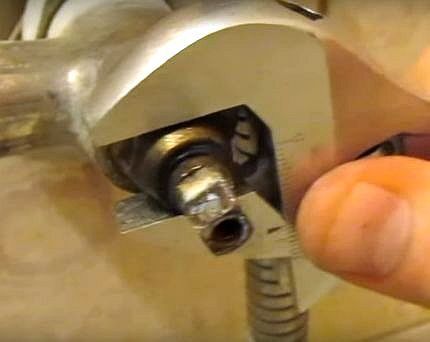
The edges of cheap Chinese heads are very easy to lick, so it is advisable to unscrew them with well-fitting open-end or box wrenches.
Third. It is necessary to remove the old worn rubber gasket and install a new one. An elastic band costs a penny, but it will provide several years of peace of mind to your nerves. And if you have a choice, you need to buy products from more reliable manufacturers.
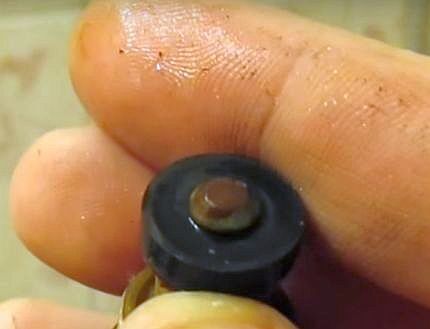
Before installing the gasket, it is necessary to check its lower surface for smoothness and, if there are defects, cut off the protruding parts. It is better to cut a small chamfer along the circumference from the bottom side so that the gasket is pressed more tightly against the saddle and the crane does not buzz
Fourth. Dry and scrub the seat on the faucet body with a steel wool or other abrasive material, and then wipe it clean.
Fifth. Screw the head into place and close the valve with a decorative body.
After the above steps, you can make sure that the faucet is not leaking and the unnerving rhythmic dripping of water into the sink has disappeared.
Flag mixer repair
Flag (single-lever) mixers have become widespread because of their ergonomics: you do not need to turn the valves for a long time, smearing them with grease and flour in the kitchen. Despite the external simplicity and elegance of the forms of such cranes, the algorithm of their work is rather complicated.
In order to increase the level of maintainability of flag mixers, manufacturers began to use a modular type of design: a special cartridge is installed inside the case, containing all the necessary mechanical stuffing. Therefore, special knowledge is not required to understand how to eliminate a leak in a flag valve: with most breakdowns, the entire cartridge is replaced.
Leakage of water with the tap closed implies a leak between the seat and the plastic or ceramic cartridge regulators. You can try to disassemble and clean some models, but the probability of returning the cartridges to working capacity and eliminating the leak is very small. To quickly replace the internal filling of the flag valve, do the following.
First. We remove the decorative colored cap-stub. It serves not only to cover the bolt, but also indicates the position of the lever when supplying cold and warm water.
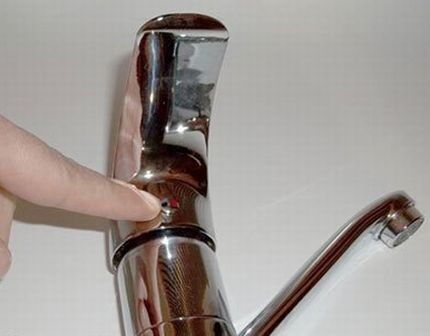
Remember the correct position of the cap in order to put it back in the future - this will allow people not to get confused with the inclusion of warm or cold water
Second. In the opened hole, it is necessary to unscrew the fixing bolt that secures the lever to the cartridge.
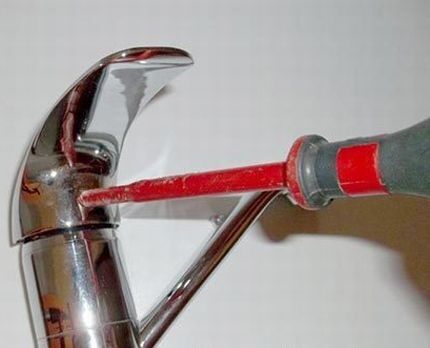
Unscrew the bolt with a suitable screwdriver: if the grooves on the cap “merge”, then it is highly likely that sawing of the lever and its replacement will be required
Remove the faucet handle.
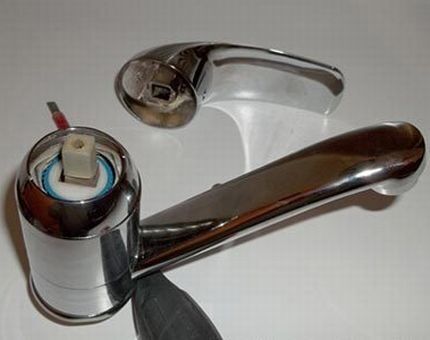
The removed lever, taking advantage of the moment, can be cleaned. To do this, it is recommended to use a cleaning agent without abrasive and scratching particles.
Third. The cartridge is closed with a decorative cap, which must be unscrewed by hand. Under the cover is a large circular nut, which presents a major problem for those who want to change the cartridge themselves. To unscrew this nut, an adjustable wrench with a gap of 27-32 mm is required. Such keys are not in the back room of every owner, so you need to worry about their presence in advance.
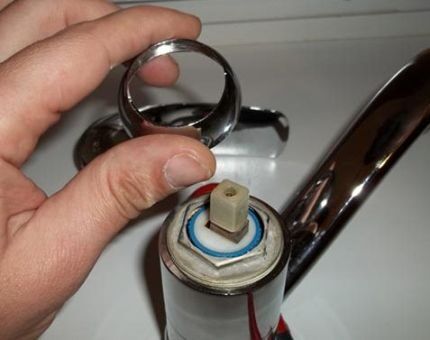
When disassembling the tap locking mechanism, we remember in what sequence the parts were removed in order to install them back in the same order. For convenience, it is better to lay out the removed parts on a flat surface in this order.
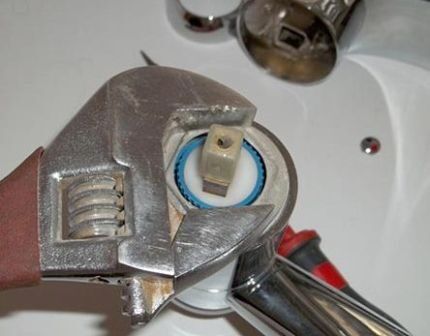
The circular nut is very narrow, so the old Soviet wrenches, which have smooth edges, are often unable to unscrew it. It is recommended to use modern keys with clear edges to remove it.
Fourth. After unscrewing the nut, the cartridge is pulled out and replaced with a similar new one.
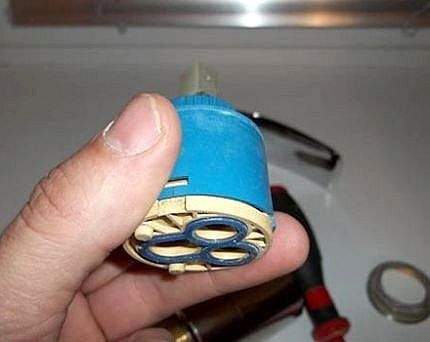
If you have saved the packaging from the old tap, then with its help you can buy a suitable cartridge model in advance in the store. If the type of faucet is unknown, then you will have to repair the faucet in the morning or afternoon, so that after disassembling it you can go to the store and buy a similar part.
The cartridge has special protrusions on the lower half that correspond to the pits on the saddle. They are needed to fix the parts in a well-defined position.
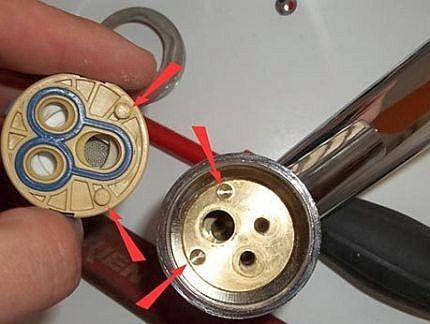
The guides on the cartridge are necessary not so much for the correct location of the holes, but for a clear centering of the location of the sealing gum
After installing the cartridge, the faucet components are assembled in reverse order.
If microcracks or grooves in the saddle are the cause of the water leak, you can try to grind the metal surrounding the hole with a drill with a small grinding head. Large cracks cannot be repaired and are a clear sign that you need to buy a new faucet.
Leak at the base of the valve
The flywheel, also known as a valve, is designed to regulate the flow of water through the spout tube. The control head (crane box) is usually attached to the valve body with a threaded connection and contains one or more sealing rings to seal the interior of the mixer. Below are two diagrams of the locking devices of a faucet mixer in comparison with a single-lever faucet (right).
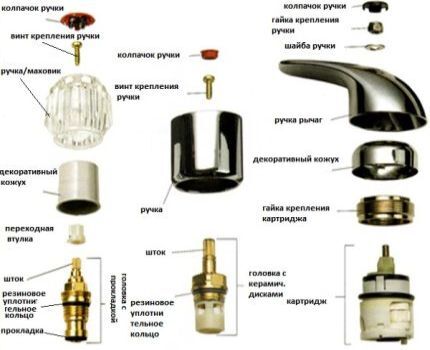
Different designs of flywheels require o-rings and locking rubber bands of various sizes, so it is not recommended to specifically buy them in advance
The flywheels are covered with decorative covers that are attached to the heads with a screw or bolt hidden under a small cap.
Causes of valve leakage
The control head has a complex internal structure.
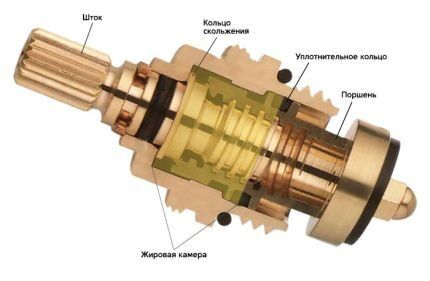
Between the head body and the stem there may be sealing rings, bushings, sealing lubricants, which in most cases cannot be replaced
Water from under the valve cover can ooze with such breakdowns:
- Insufficient level of sealing of the head:
- the crane box is not sufficiently pressed against the mixer body (in modern models);
- poor-quality thread winding when screwing in the head (in older models of taps without o-rings).
- Damaged rubber gaskets or rings between the mixer body and the axle box.
- Aged stuffing box packing. With this breakdown, an increase in leakage is observed with the tap open.
Before diagnosing the reasons for the leakage of the valve, it is necessary to shut off the general water supply in the apartment and remove the decorative casings from the flywheel.
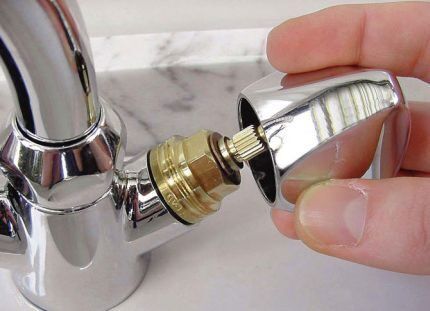
Do not use strong force when removing the casing without first studying how it is attached: you can break the crane
After gaining access to the adjusting head, open the water and determine the places where the water oozes from. Then shut off the water again and proceed with the repair.
Leak elimination methods
It is necessary to consider ways to repair the valve mechanism, taking into account the place where water flows.
Option one: water flows from under the stem.
If there is a non-separable adjusting head in the crane, then there is only one way out: buy and install a new crane box, there is no other way. However, most conscientious faucet manufacturers usually insert repairable heads into their products. If they have a stuffing box on top, then you can try to tighten it with a key and check for leaks.
When water flows with the stuffing box clamped as much as possible, you can disassemble the head, remove the seal and try to replace it. Adjusting faucet boxes in most mixers are standardized, but it is not always possible to find a new gland of the required design on sale. If it is not possible to repair a leaking head by replacing the stuffing box, then it should be replaced with a new one.
Option two: water flows out at the junction of the mixer head and body.
The easiest way to solve this problem is to press the head against the mixer body with a wrench. If the result of this action is negative, it is necessary to unscrew the crane box and check the seals. Perhaps, during the initial installation of the crane, they moved to the side or twisted, which eventually leaked. It is recommended to remove and reinstall the O-rings and then screw the adjusting knob back into the mixer.

The sealing ring must not be twisted. Be sure to check its location after it is finally put on the faucet head.
If the reinstallation of the gaskets did not lead to the disappearance of the leakage, then their complete replacement is required.
Instead of rubber seals in Soviet taps, tow with paint was often wound on the threads. In case of leakage from under the valve in such mixers, you must first completely clean the head from the remnants of the sealant, and then wrap a convenient fum-tape or the same tow lubricated with silicone on the thread. After that, tightly screw the head back into the faucet and rejoice at the absence of leakage!
Another cause of leakage in the gap between the valve and the faucet may be the appearance of a small groove or scratch on the edge of the faucet body under the adjusting head gasket. If such defects are found, then the entire annular surface should be carefully treated with sandpaper until the scratch disappears, and then the crane box should be reinstalled.
If, due to serious defects in the elements of the faucet, it is impossible to stop the flow using the methods described above, then you need to prepare the family budget for the purchase of a new faucet.
Leak at the base of the gander
Due to the differences in the design of the valve and flag mixers, the causes of water leakage at the base of the gander and the methods for eliminating them are different for these taps.
Leak near faucet spout
The shower hose and spout tube (in the common people - a gander) is attached to the faucet body with a union nut, under which there is a rubber gasket. And if the faucet in your bathroom is leaking, then the reason usually lies in the wear of this gum. Often the gander has an additional 1-2 external sealing rings.
To repair a leak in this case, it is necessary to unscrew the union nut and install a new silicone or rubber gasket, as well as replace the rubber rings, if any. From the tools for this procedure, you will need an adjustable wrench, as well as an awl or a small screwdriver to remove the old rubber gasket.
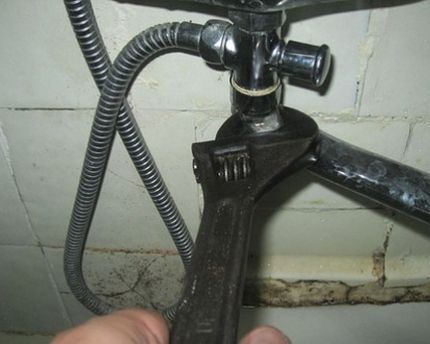
When unscrewing the decorative nut, you can wrap it with one layer of a cloth or rag to avoid scratches.
Gaskets must be stocked up in advance.

Before installing the seal, you need to carefully clean the surfaces of the body and the gander with which it will come into contact
If you need to fix the problem quickly, and there is no suitable new o-ring, then you can simply wrap the fum tape tightly around the thread and tighten the union nut with the old gasket cleaned.
Water can ooze at the base of the gander for another reason: over time, microcracks can occur in the faucet or spout body, through which water leaks. There is only one solution to such a leak - this is the replacement of the entire mixer.
Leak at the base of the flag mixer
In order to get to the seals of the base of the flag valve, it is necessary to completely dismantle it by removing it from the sink. This procedure is not easy and long, so we will consider it step by step.
The first step in repairing a faucet is to turn off the water in the house. After that, it is necessary to disconnect the flexible hoses from the supply pipe and open the mixer so that the remaining water escapes.
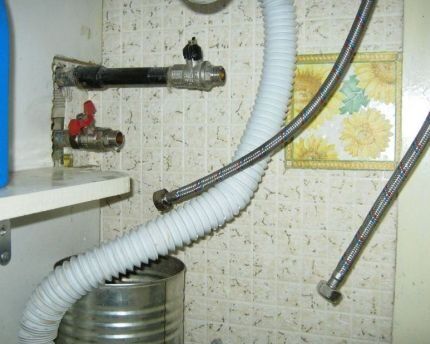
When unscrewing the connections, hold the branch pipe of the plastic pipe with your other hand so as not to break it in the place of the nearest soldering
The second step is to unscrew the fixing nut on the stud under the sink, remove the fixing bracket and pull out the faucet along with the hoses.
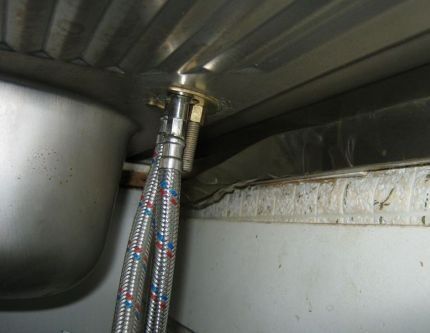
The nut is often located in an inconvenient place, so in such cases it is necessary to unscrew it with pliers or another similar tool
Then we unscrew the stud itself with a screwdriver, and disconnect the flexible hoses with an open-end wrench. If their fittings and rubber tube are worn out, then it is advisable to buy new eyeliners or, at a minimum, replace the o-rings and gaskets on both ends of the hoses.
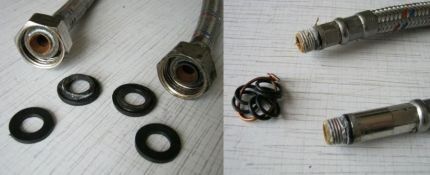
The sizes of sealing rubber bands and rings on the inlet hoses are the same on almost all models, so you can buy them in advance
The fourth step is to unscrew the threaded ring at the base of the faucet that holds the spout. We're filming a goose.
Image gallery

After installing new oil seals, it is advisable to lubricate them from above with liquid detergent or oil so that the seals do not move when putting on the gander
Silicone gaskets usually last two to three years with active use. If you plan to use the faucet for a longer period, then it is better to look in stores for ordinary rubber seals that will last a few years longer.
The last step is to assemble and install back the designer called the "flag crane", not forgetting to put the gaskets.
After installing the mixer in its original place, you need to observe for several days that there are no leaks at the base of the spout and under the sink. Once it is desirable to look at the joints after a long washing of dishes. If there is a leak under the sink and water flows through the connecting hoses, then it will be necessary to dismantle the faucet again and eliminate the leak. This problem will be discussed in detail in the next section.
Leak at the junction of the inlet pipes
Water leakage at the points of attachment of the mixer body to water pipes or hoses can occur for three reasons:
- Deterioration of seals.
- Crack in the faucet body or connecting fitting.
- Incorrect installation of flexible hoses.
If, upon inspection of the repair site, a crack in the faucet body is revealed, then you can immediately start choosing a new water tap, because this breakdown cannot be repaired. Options for eliminating other causes of leakage will differ for taps with flexible supply hoses and for mixers that are supplied with water from hard plastic or metal pipes.
Repair of leaking pipes in the bathroom
The flow of water at the junction of the faucet body and the pipes built into the wall is eliminated similarly to the leakage of a faucet mixer at the base of the spout, the instructions for eliminating which are described above. In both cases, the connection of two tubes occurs due to the union nut, under which there is a sealing gum.
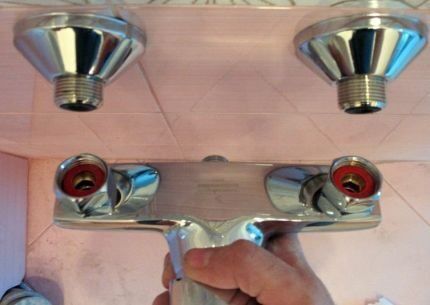
Holes in the wall for pipes are covered with decorative covers, which should not be forgotten to be put on when reinstalling the mixer
An important nuance of the procedure for replacing the gasket when installing a two-pipe mixer is the synchronous unscrewing and tightening of both union nuts. Otherwise, distortion will occur, which can result in displacement of the gaskets and even licking of the threaded connection. And damage to the thread of the nut of an exclusive tap can lead, at a minimum, to the need to install home-made parts with an unsightly look.
Elimination of leaks in the supply hoses
Consider the elimination of water leakage at the junction of the hoses and the faucet body using the example of one of the most common faucet models.
The first step is to block the access of water to the tap and unscrew the flexible hoses from the water supply pipes. Then unscrew the mixer valves and drain the water from the tubes.
On the sink body, the faucet is attached from below with a bracket pressed by a nut on a stud. It is necessary to unscrew the mount with a key and carefully remove the faucet from the sink by pulling the hoses up through the hole. In principle, you can not remove the faucet from the sink, but unscrew the water hoses directly below. But hardly anyone will like to do gymnastic exercises in the limited space of a sink.
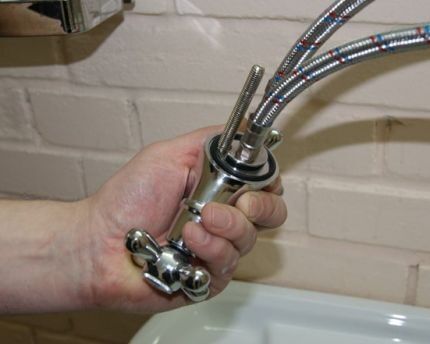
It is better to unscrew the hoses after removing them from under the sink, and it is necessary to pull the tubes through the hole in turn
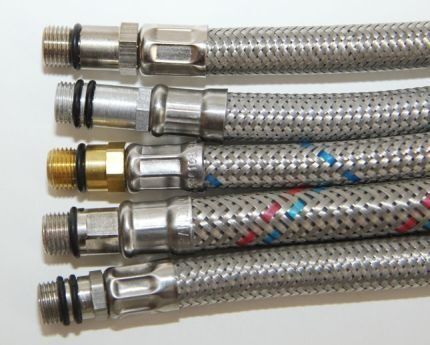
The length of the thread of the fitting itself, as well as the number of ring rubber bands, may differ. In some models, even the shape of the inlet fittings for hot and cold water is different, so when unscrewing the fittings, you should make sure which one is screwed into which hole.
When the inlet rubber tubes are worn out, it is better to buy new ones, because when re-assembling there is a high probability of their complete rupture. Due to the variety of fitting designs, you need to take old hoses to the store with you as an example.
After installing new rings or buying new hoses, you can mount the valve in place, following the reverse procedure. It is very important when tightening the hose fittings not to tighten them too much, because the thin o-rings can turn out or simply “smear”. Sometimes it is enough just to clamp the hoses with your hands.
The main problem of mounting and dismounting the mixer is the limited working space. Often, long open-end wrenches simply cannot be placed to unscrew the nut. In such situations, you can lubricate the threads of the stud with oil and unscrew the nut with pliers.
If all the above steps were carried out correctly, then the leak should stop. Although sometimes you have to unscrew and twist the hoses again due to the poor quality of the o-rings and their displacement.
Faucet Repair Video Instructions
Video clips will help to consider the internal structure of the faucets and make it easier to understand how to eliminate the leakage of the faucet.
Fixing a leak at the base of a single-lever faucet spout:
Replacing flexible hoses on a faucet:
Dismantling and repair of the crane box:
The knowledge presented here in the field of faucet repair will always help a good owner to determine the reason why the faucet is leaking and decide how to fix it.
